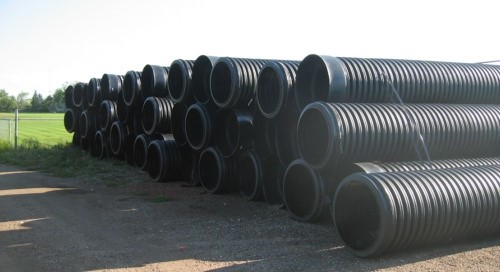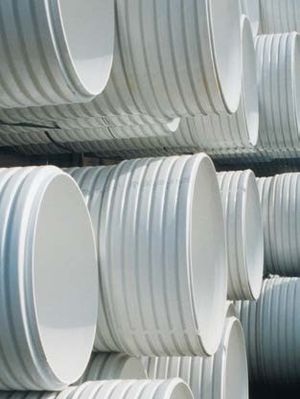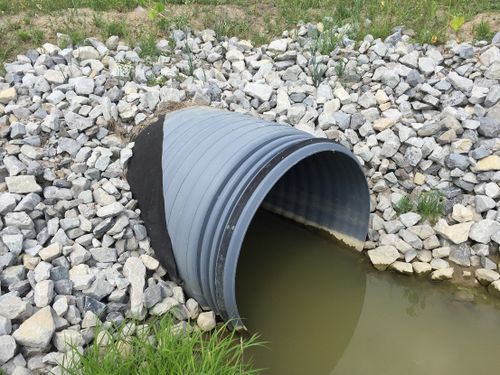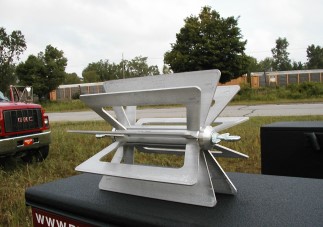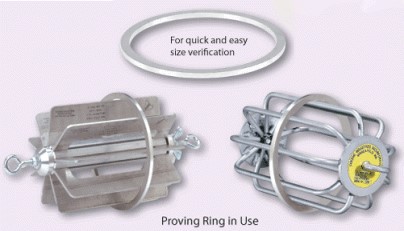Mandrel Testing of Plastic Pipe
Mandrel Testing of Plastic Pipe
Plastic pipe, also referred to as flexible pipe, is manufactured using a variety of different materials. Currently the only materials used to manufacture plastic pipe that are acceptable for use on department projects for storm sewer and culverts is polyethylene (CPE), polyvinyl chloride (CPV) and polypropylene (PPP). The AASHTO standards covering these types of plastic pipe are M294, M304 and M330, respectively. For identification purposes photos of the different types of plastic pipe are provided below. The pipe is all corrugated and CPE is black, CPV is white and PPP is gray.
When plastic pipe, manufactured using any of the above materials, is installed on a project for a storm sewer or culvert application it may be subject to mandrel testing. In accordance with the standard specifications, at least 50 percent of the installed length of each size of plastic pipe must be tested for deformation using a nine point mandrel. The effective diameter of the mandrel must be 95 percent of the nominal pipe diameter and verified using a proving ring. The mandrel is sized to allow for up to 5% deformation of the installed pipe. Nominal pipe diameters are defined in the respective AASHTO standards. The Contractor is required to provide the appropriately sized mandrel and proving ring. The proving ring is used by the inspector to verify that the diameter of the mandrel is appropriate for the diameter of pipe being tested before it is used. Photos of a typical mandrel and proving ring are provided below.
The Contractor must perform the mandrel testing after the required backfilling and compaction of the trench is completed, but between 5 and 10 work days prior to pavement surfacing or completion of final grade, except as otherwise approved by the Engineer. The Engineer will select those runs of pipe that must be mandrel tested. When testing storm sewer, the Contractor will access the pipe from one drainage structure and pull the mandrel through to the next drainage structure. For pipe with a diameter larger than the access to the drainage structure the contractor must provide a mandrel that can be disassembled on the ground surface and reassembled in the drainage structure to facilitate testing. The mandrel must be pulled through the pipe by hand without any mechanical advantage. If the mandrel can be pulled through the entire run of pipe the test passes and the pipe can be accepted for deformation testing.
If the mandrel cannot be pulled through a run of pipe by hand the deformation testing has failed. The Contractor should attempt to pull the mandrel through the pipe from the opposite direction to better identify the length of pipe in the run impacted by excessive deformation. All plastic pipe that do not have successful mandrel test results (5% or less deformation) are not acceptable and must be removed and reinstalled or replaced. If the Contractor elects to reinstall removed plastic pipe they must first obtain approval by the Engineer to ensure the pipe is not damaged. All reinstalled or replaced plastic is subject to mandrel testing. The use of a vibratory pipe rerounder is not an acceptable means to rectify failed mandrel test results.
The Contractor is responsible for all costs and delays associated with corrective actions necessitated by failed mandrel test results.
All mandrel test results for plastic pipe must be recorded by the inspector on one of two forms:
Distribution details are found on the forms. The forms should be stored in accordance with MDOT e-Construction guidance.
Different Types of Plastic Pipe
Corrugated Polyethylene Pipe (CPE)
Corrugated Polyvinyl Chloride Pipe (CPV)
Corrugated Polypropylene Pipe (PPP)
Nine Point Mandrel
Nine Point Mandrel with Proving Rings
